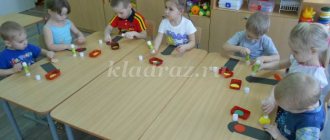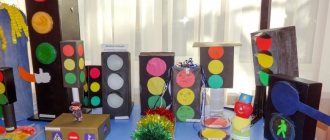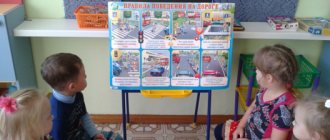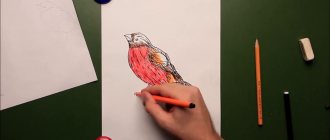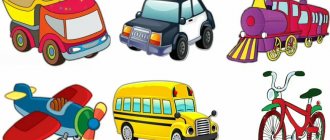Notes on drawing "Pedestrian crossing" in the second junior group
Buraeva Larisa
Notes on drawing "Pedestrian crossing" in the second junior group
Topic: " Pedestrian crossing "
.
Goal: To teach children to paint a pedestrian crossing .
Educational: Teach children to hold the brush correctly so that the hand and brush can move freely while drawing .
Developmental: Form an idea of a pedestrian crossing .
Educational: To cultivate interest in visual arts.
Integration of educational areas: Artistic and aesthetic development, cognitive development, social and communicative development, physical development.
Vocabulary work: Pedestrian crossing , sidewalk, traffic light.
Vocabulary work: Pedestrian crossing , sidewalk, traffic light.
Materials and equipment: Traffic light model, pedestrian crossing , pedestrian crossing , sheets of paper, black paint, brushes, napkins.
Methods and techniques: Visual, verbal, practical, demonstration, explanation
Preliminary work: Examination of illustrations depicting a pedestrian crossing , a walk outside.
Preview:
Abstract of GCD for drawing on the topic: “Traffic light” in the second junior group
1. Introduce children to traffic lights and their purpose
2. Consolidate knowledge of primary colors (yellow, red, green)
3. Strengthen the ability to draw round objects with a continuous continuous movement of the brush.
4. Introduce children to the rules of behavior on the road
5. Introduce children to the rules for correctly crossing a road using a traffic light.
1. Continue to introduce kids to gouache paints
2. Develop the skill of decorating an object with gouache paints
3. Remember and reinforce the rules of behavior on the road that children are already familiar with
— Parents and children examining traffic lights at intersections;
- Examination of illustrations in books depicting traffic lights;
— Clarify what color and shape the traffic lights are.
Demonstration material: drawn traffic light, traffic light layout,
circles of red, yellow and green, V. Likhoded’s book “Lessons”
Handout: ½ album sheet, brush, gouache paints.
Educator: Guys, I’ll now read a poem to you, and you listen carefully and tell me who (what) we’re talking about:
Let's start the conversation We're talking about an important traffic light! He stands on the road, watching the traffic. If the red light is on, the traffic light tells us: -Stay still! do not go!
Wait a little. The bright yellow light is on, “Get ready,” it says. The traffic light warns that it is switching the light. He turned on the green light, He allowed us the path forward, All the cars are waiting together: Children and mothers are walking. V. Likhoded
Educator: What do you guys think this poem is about? (about traffic lights, traffic rules)
Educator: Why do we need a traffic light? (in order to regulate traffic on the roads, help pedestrians cross the road when the light is green, to prevent accidents)
Educator: If the traffic light shows us a red signal, what does it mean? (that there are cars driving along the road and you can’t cross the road)
Educator: What traffic light signal warns us that we need to get ready? (yellow, you can’t switch to yellow)
Educator: What traffic light signal tells us that we can cross the road? (green)
Then it is proposed to play the game “Traffic Light”. Children stand near the chairs. The teacher shows traffic light signals (circles of red, yellow and green). When the color is red, children stand, when the color is yellow, they raise their hands, and when the color is green, they walk in place.
Direct visual activity
Educator: Today we will draw traffic lights
— What shape are traffic light signals? (round).
Call someone to the traffic light model, invite the called child to trace the traffic light signals along the contour with a hand movement. After this, have everyone point their fingers in the air and show them which round traffic lights they have. When showing the image technique, emphasize that you need to draw round objects with a continuous continuous movement of the brush.
Educator: During independent work, the teacher keeps all the children in sight, watches how the children hold the brush, draw circles at once, without stopping. They paint without going beyond the outline, helps those who have difficulty coloring, and draws children’s attention to the sequence of colors in a traffic light.
At the end of the lesson there is an exhibition of works.
On the topic: methodological developments, presentations and notes
Development of gaming activities, familiarization with elementary generally accepted norms and rules of relationships with peers and adults (including moral ones). Form a holistic picture of the world, including.
Goal: to introduce children to basic traffic rules. Reinforce knowledge about the meaning of traffic lights.
Summary of a drawing lesson with elements of the application “Family on the Palm” in the second junior group. The selected material for the lesson evoked a positive emotional response from the children for a long time.
Use of non-traditional techniques.
Municipal budgetary preschool educational institution kindergarten "Chechek" village. Kyzyl-Mazhalyk Barun-Khemchik kozhuun of the Republic of Tyva Abstract directly.
Children draw a sunflower using an unconventional drawing method - with a poke of a cotton swab.
Traffic rules are an important topic nowadays. Children constantly need to be reminded about safety on the street. A lesson on plasticineography on the topic “Traffic Light” will help consolidate pr.
Source
Summary of OOD on traffic rules for children 2 - 3 years old “Pedestrian crossing”
Summary of organized educational activities with children of the first junior group (2 – 3 years old)
within the educational field “Cognitive Development”
on the topic "Pedestrian crossing".
Goal: familiarize children with the rules for safely crossing the road at a pedestrian crossing.
Tasks:
Educational: to form children’s ideas about correct behavior on the road; consolidate knowledge about types of transport, machine parts; learn to draw straight horizontal lines.
Developmental: develop interest in learning traffic rules, speech activity and articulation of children.
Educators: cultivate a conscious attitude towards the rules of safe behavior on the road.
Equipment: “Masha” doll, road with a pedestrian crossing, “Pedestrian crossing” sign, toy cars, cut-out pictures “Transport”.
OOD progress.
Educator. Guys, the doll Masha came to visit us. Let's say hello to her. (The children greet the doll, the teacher notices that the doll is upset about something.) Masha, tell me what happened to you (the doll speaks to the teacher in the ear). Masha was very scared today when she saw cars on the road.
Doll.
I was walking across the road
And I got a little confused
When to stand, when to go
And where to cross the road
Educator. Guys, let's help Masha. Masha went for a walk alone and there was no one to tell her where to cross the road. Do you think small children can walk alone?
Educator. Right! Children should walk with adults: with mom, dad, grandparents.
Guys, let's take a walk along the path. (get up from the chairs)
Fizminutka
Top, top legs
We walked along the path
The legs walked, walked, walked
And they came to the road.
Educator. Guys, look at the road there are some white stripes. They look like a zebra. This is a pedestrian crossing. The crossing is also indicated by this sign (look at the pedestrian crossing sign).
Educator. When crossing the road you need to be very attentive and careful. Holding hands is a must. First look left, then right. You can cross the road only if there are no cars.
Educator. Guys, let's become pedestrians and try to cross the road.
Game "We are pedestrians"
Guys, let's join hands. Let's look left, then right. And if there are no cars, then we cross the road. The game can be repeated several times.
Educator. Now Masha remembers how to cross the road correctly.
Educator. Guys, let's see what cars are driving on the road.
What kind of car is this? (Car). Who is she transporting? (Of people).
Let's see what parts the machine consists of.
Educator. What kind of car is this? (Cargo). What parts does this machine consist of? What can be transported in the truck?
Educator. How do the cars sound? (W-w-w). Let's all hum together, first quietly, then loudly.
Now let's honk the horn. (Beep) Quiet and loud.
Educator . Look what happened to these cars. They broke down and all the parts got mixed up. Can you fix cars?
D/game “Assemble cars ” (cut-out pictures).
Educator. Now the cars are ready to go. Where do the cars go? (On the way to).
Educator. Let's draw a road for our cars.
Drawing roads for cars.
Outline of a drawing lesson “I am a Traffic Light” for the second junior group of kindergarten
Olga Melikova
Outline of a drawing lesson “I am a Traffic Light” for the second junior group of kindergarten
1. Introduce children to traffic lights and their purpose
2. Consolidate knowledge of primary colors (yellow, red, green)
3. Introduce children to the rules of behavior on the road
4. Introduce children to the rules of correct road crossing
1. Continue to introduce kids to gouache paints
2. Develop the skill of decorating an object with gouache paints
3. Remember and reinforce the rules of behavior on the road that children are already familiar with
Handouts for children:
1. Landscape sheet with a picture of a traffic light
Material for the teacher
1. Card with a picture of a traffic light
2. Book by V. Likhoded “ Traffic Light ”
